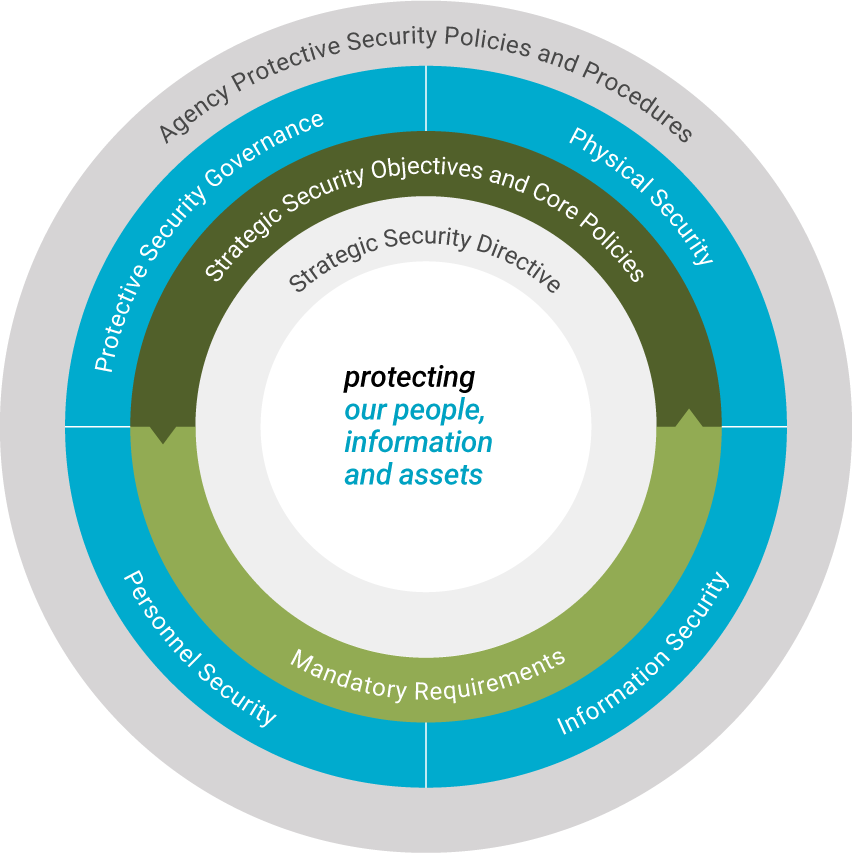ABOUT005

New Zealand's policy framework for protective security has four tiers and a hierarchical structure. The four tiers support government and private sector organisations to implement protective security measures.
ABOUT005

New Zealand's policy framework for protective security has four tiers and a hierarchical structure. The four tiers support government and private sector organisations to implement protective security measures.
The strategic security directive is the New Zealand Government's overarching security policy statement. It’s the keystone of the PSR.
The directive articulates the government's requirement for protective security: that it enables organisations to work together securely in an environment of trust and confidence.
Tier 2 contains the mandatory requirements that government organisations must implement to ensure a consistent and controlled security environment throughout the public sector. Once implemented, this tier enables government organisations to have more confidence in information-sharing practices and collaborative working arrangements.
The mandatory requirements cover four key areas – security governance, personnel security, information security, and physical security. All organisations who adopt the PSR should comply with these requirements.
GOV 1 – Establish and maintain the right governance
GOV 2 – Take a risk-based approach
GOV 3 – Prepare for business continuity
GOV 4 – Build security awareness
GOV 5 – Manage risks when working with others
GOV 6 – Manage security incidents
GOV 7 – Be able to respond to increased threat levels
GOV 8 – Assess your capability
PERSEC 1 – Recruit the right person
PERSEC 2 – Ensure their ongoing suitability
PERSEC 3 – Manage their departure
PERSEC 4 – Manage national security clearances
INFOSEC 1 – Understand what you need to protect
INFOSEC 2 – Design your information security
INFOSEC 3 – Validate your security measures
INFOSEC 4 – Keep your security up to date
PHYSEC 1 – Understand what you need to protect
PHYSEC 2 – Design your physical security
PHYSEC 3 – Validate your security measures
PHYSEC 4 – Keep your security up to date
Tier 3 provides detailed management protocols and guidance to support your organisation to implement the mandatory requirements and establish best-practice security measures.
Key best-practice documents include:
These documents standardise protective security practices across government to:
The New Zealand Government will continue to develop and refine protective security policy that promotes the most effective and efficient ways to securely deliver government business.
Good security governance is about conforming and performing.
‘Conforming’ means your organisation meets the PSR’s mandatory requirements.
‘Performing’ means your organisation uses security measures to:
Applying governance principles
The PSR is based on the principles of public sector governance, including:
The people your organisation employs must be suitable for having access to official information and assets. They must meet standards for integrity, honesty, and tolerance.
When necessary, your people must get a security clearance at the appropriate level.
Your organisation is responsible for managing your people throughout the employment lifecycle to prevent accidental or intentional security breaches.
The mandatory requirements for information security are based on the following elements:
Your organisation must also apply safeguards so that:
Your organisation must provide and maintain:
Your organisation must develop security policies, plans, and procedures that meet your business needs.
Your policies and procedures should: